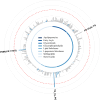Mendelian randomization analysis reveals causal effects of blood lipidome on gestational diabetes mellitus
- PMID: 39261922
- PMCID: PMC11391602
- DOI: 10.1186/s12933-024-02429-2
Mendelian randomization analysis reveals causal effects of blood lipidome on gestational diabetes mellitus
Abstract
Background: Observational studies have revealed associations between maternal lipid metabolites and gestational diabetes mellitus (GDM). However, whether these associations are causal remain uncertain.
Objective: To evaluate the causal relationship between lipid metabolites and GDM.
Methods: A two-sample Mendelian randomization (MR) analysis was performed based on summary statistics. Sensitivity analyses, validation analyses and reverse MR analyses were conducted to assess the robustness of the MR results. Additionally, a phenome-wide MR (Phe-MR) analysis was performed to evaluate potential side effects of the targeted lipid metabolites.
Results: A total of 295 lipid metabolites were included in this study, 29 of them had three or more instrumental variables (IVs) suitable for sensitivity analyses. The ratio of triglycerides to phosphoglycerides (TG_by_PG) was identified as a potential causal biomarker for GDM (inverse variance weighted (IVW) estimate: odds ratio (OR) = 2.147, 95% confidential interval (95% CI) 1.415-3.257, P = 3.26e-4), which was confirmed by validation and reverse MR results. Two other lipid metabolites, palmitoyl sphingomyelin (d18:1/16:0) (PSM(d18:1/16:0)) (IVW estimate: OR = 0.747, 95% CI 0.583-0.956, P = 0.021) and triglycerides in very small very low-density lipoprotein (XS_VLDL_TG) (IVW estimate: OR = 2.948, 95% CI 1.197-5.215, P = 0.015), were identified as suggestive potential biomarkers for GDM using a conventional cut-off P-value of 0.05. Phe-MR results indicated that lowering TG_by_PG had detrimental effects on two diseases but advantageous effects on the other 13 diseases.
Conclusion: Genetically predicted elevated TG_by_PG are causally associated with an increased risk of GDM. Side-effect profiles indicate that TG_by_PG might be a target for GDM prevention, though caution is advised due to potential adverse effects on other conditions.
Keywords: Gestational diabetes mellitus; Lipid metabolites; Phenome-wide Mendelian randomization; Two-sample Mendelian randomization.
© 2024. The Author(s).
Conflict of interest statement
The authors declare no competing interests.
Figures




References
Publication types
MeSH terms
Substances
Grants and funding
LinkOut - more resources
Full Text Sources
Miscellaneous

